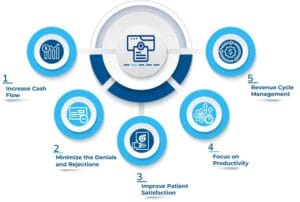Payment posting, often known as cash posting, is a medical billing process that includes a full description of the financial situation. In order to guarantee smooth operations, the entire procedure is conducted using healthcare billing software. Similarly, ineffective cash posting, delayed payer reimbursement, and denied claims cause significant losses for healthcare companies. It is impossible to receive complete reimbursement without cash posting; hence, it is an essential component of RCM.
The influence of efficient cash posting on patient satisfaction and overall financial health is also very significant. Read on to find out more about how the payment posting can work. Keep reading its procedure and its role in enhancing revenue.
What Is Payment Posting in Medical Billing?
Payment posting refers to checking and looking at payments and includes details information about the financial status. It also involves keeping track of one’s financial situation. This method accounts for the payment and accumulates the money. In medical billing, a medical biller held the process of cash posting after all the procedures.
It involves making careful entries for payments in the medical billing system. It thus gives clear information about payments from patients, ERAs containing insurance checks, and insurance payments showing up in EOBs. If you are facing issues with cash posting and could focus on patient care, you can schedule a free consultation with MAVA Care. We are here to handle all your billing-related tasks with accuracy and precision.
Payment Posting Process in Medical Billing
i. Manual Posting
In a manual posting, EOBs would then be sent to the posting team by straight provider pickup, pre-paid letter shipment, or scanning at the physician’s office. Posting occurs only after creating groups of payments. This batch system helps with proper accounting; money deposited into the doctors’ checking accounts will match our posting exactly.
ii. Auto Posting
In auto cash posting, EOB payments come in as ERA files. These downloads directly into the provider’s practice management system. All postings occur right in the system so that the provider can view them whenever desired.
What Are the Steps in Payment Posting?

Claims are processed and adjudicated against the insurance payer, then paid or denied to the claimant. The supplier and the member receive a document called an Explanation of Benefits (EOB) or Explanation of Payments (EOP).
1-Patient Balances
Multiple charges assigned liability to the patient. The account should balance, and the balance should be presented to the patient for collection without delay.
2-Assessing Denials
Accounts Receivable must work on disallowed claims, which require precise posting of reimbursements or EOBs. Also, it helps in identifying problems with payers with many patients.
3-Identifying Internal Issues
It includes payment and denial, and information reveals internal process problems, specifically prior authorization or coding flaws, thus providing the avenue of correction through the prevention of future claims with a chance to correct at least a few of those already denied.
4-Claims Processing
Many patients have more than one payer. Fast processing of EOBs from the main payer to the second or even third payer will lead to quicker full payment of the claim.
5-Data Analysis
Collecting payment and denial information allows businesses to assess their entire company’s activities. It can aid in the prediction of income and the development of business strategies to improve operations.
6- Check Payments with ERAs/EOBs
Checks, credit card payments, and electronic fund transfers must be checked to corresponding statements of payers that incoming money matches. Money could have been sent in the wrong place, or checks may have gotten lost.
Role of Payment Posting in Revenue Cycle
The following are some ways that cash posting improves the revenue cycle and improves your bottom line:
- The report rejected claims to proper teams for quick rework and resubmission to payers.
- Provide insights on trends in previous authorizations, denials, non-covered procedures, deductibles, and copayment collection issues at the point of service.
- Post and reconcile EOB and ERA. It also includes the date from ERA and EOB similar payments.
- Process payment adjustments and write-offs and report any odd contractual modifications.
- Transferring patient balances leads to speedier billing.
ERA Payment Posting in Medical Billing
An electronic remittance advice (ERA) is a report that insurance companies (both federal and private) send to medical service providers. ERA includes details like:
- Paid claims and claim status
- Reimbursement amount
- Adjustments for agreements
- Secondary payers, benefits coverage
- Estimated copayments and coinsurance
- Patient financial responsibility has been implemented
- Payments can be bundled or separated
EFT Payment Posting in Medical Billing
Insurance companies employ electronic money transfers (EFT) to reimburse claims straight to the medical service provider’s account. In the EFT technique, insurance firms send an electronic message to a banking agency (ACH Network) to execute an online payment transaction. The EFT message contains:
- Payment amount.
- Identify the payer and payee.
- Bank accounts for payer and payee.
- Routing numbers.
- Date of payment.
Compared to checks, electronic fund transfers (EFT) are quicker, safer, and more effective ways to deposit reimbursement payments. EFT is extremely advantageous to medical practitioners since it allows them to better manage multiple accounts and payments from different insurance carriers.
EOB Payment Posting in Medical Billing
Explanation of Benefits (EOB) is manual documentation of the report issued by insurance companies to medical care providers, containing data like:
- Payment of claims.
- Determine claim status.
- Reimbursed amount and modifications.
Based on agreements, secondary payers, benefits coverage, estimated copayments, coinsurance, and explanations of claim denial, as well as refused codes and services, patient monetary responsibility that has been imposed, payment combining or division, and payment methods.
Why Accurate Payment Posting is Essential?

Accurate cash posting means that payments are accurately documented and accounts receivable are properly managed. It enables healthcare professionals to:
I. Increase Cash Flow
Accurate cash posting services verify that healthcare providers receive timely and correct reimbursements. Therefore, in turn, it improves cash flow by reducing the risk of late payments, rejected claims, or inaccurate payment amounts. Accurate cash posting allows healthcare providers to detect problems and take preventative measures to limit the likelihood of revenue loss.
II. Minimize the Denials and Rejections
The probability of claim denials and rejections is reduced when payments are posted accurately. Healthcare providers can avoid claims rejections by ensuring that payments are made correctly. It saves time and effort spent rewriting rejected claims and minimizes the time it takes to get payment.
III. Improve Patient Satisfaction
Proper cash posting improves patient satisfaction. Patients are more likely to be at ease when their bills are correct, and they receive clear and timely payment instructions. It encourages favorable assessments and referrals and boosts patient loyalty.
IV. Focus on Productivity
Adequate cash posting improves efficiency. By lowering the probability of rejects and rejections, healthcare practitioners can save time and dollars on rewriting claims. It improves productivity since healthcare practitioners can focus on providing great care rather than dealing with payment concerns.
V. Revenue Cycle Management
Suitable and correct cash posting allows healthcare practitioners to reduce revenue loss due to payment issues or delays while also better tracking financial success. It can help enhance cash flow and financial stability while ensuring that patients are billed correctly and effectively.
Bottom Line
Payment posting is a critical task that requires careful work. It involves matching insurance payments with the services provided to patients. During payment processing, our team of payment posting specialist at MAVA Care carefully reviews each payment received from insurance companies or patients in detail. We check the payment amount to the original medical bill. We also update the patient’s account balance and mark the specific services as paid. Finally, we enter the payment information into our billing system to ensure accurate financial tracking and record-keeping.
FAQ’s
1-What is a payment posting?
Payment posting is a key step in medical billing where you can record all payments received from insurance companies or patients into our practice’s financial system. This process helps you to keep precise financial records, identify any discrepancies quickly, and maintain a clear picture of our practice’s revenue.
2-Are there any similarities between cash posting and payment posting?
Payment posting is the process of recording payments received from insurance companies or patients into a medical practice’s financial system. Cash posting is the process of documenting direct patient payments made in cash or checks. So, payment posting covers all types of payments, while cash posting focuses solely on physical monetary transactions made by patients.
3-Is the payment posting the same as the invoice date?
No, the payment posting date and invoice date are typically different:
- The date of the invoice’s creation and initial delivery to the client is known as the billing date.
- The date on which the payment is entered into the accounting system is known as the payment posting date.
- These dates can vary depending on when the company receives and processes the payment.
4-What are the common errors in payment posting?
Here are common errors in payment posting:
- Incorrect patient or account matching, leading to payments being applied to the wrong account.
- Misapplication of payments across different service dates or insurance claims.
- Data entry mistakes such as transposing numbers or mistyping payment amounts.








